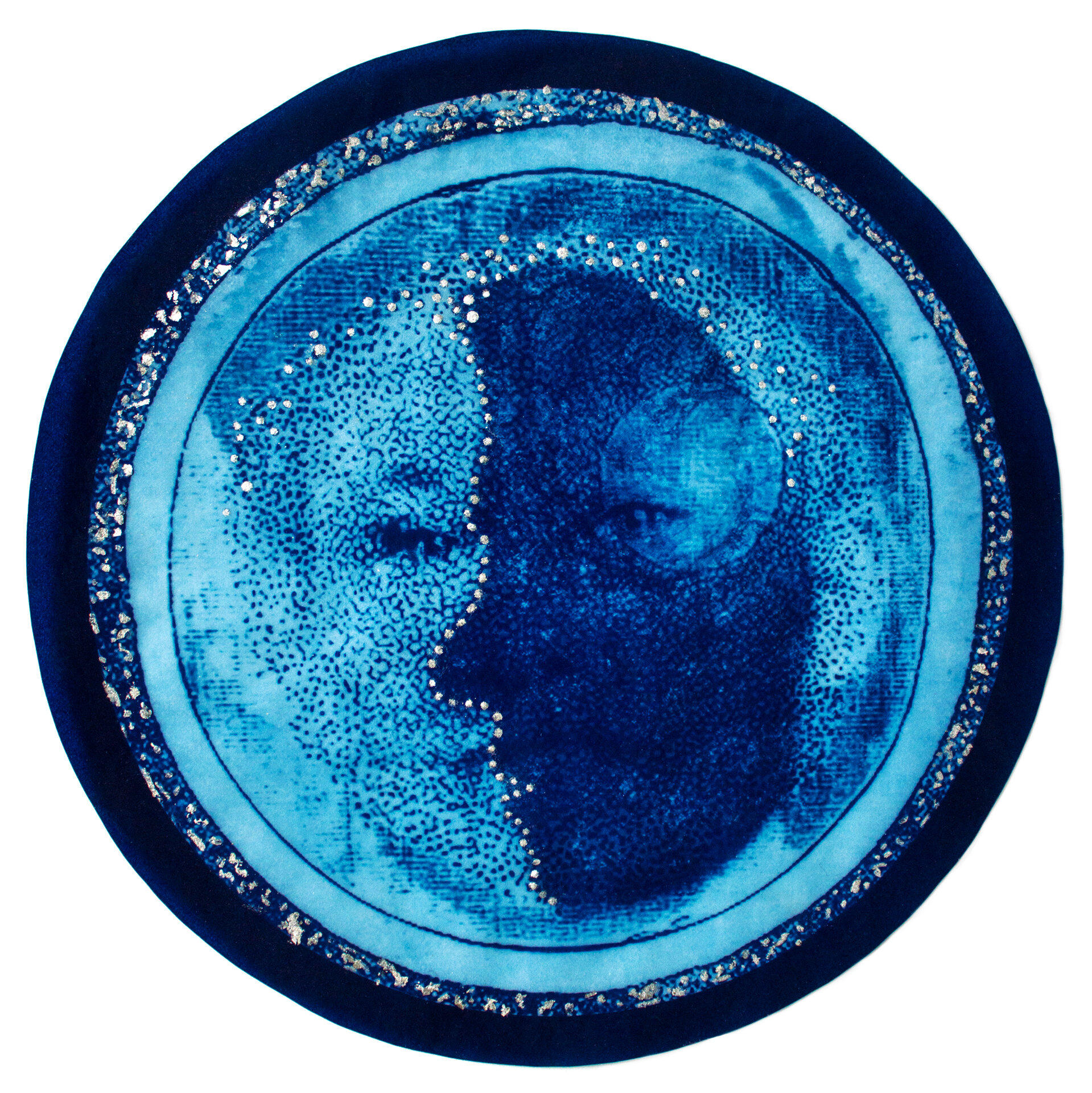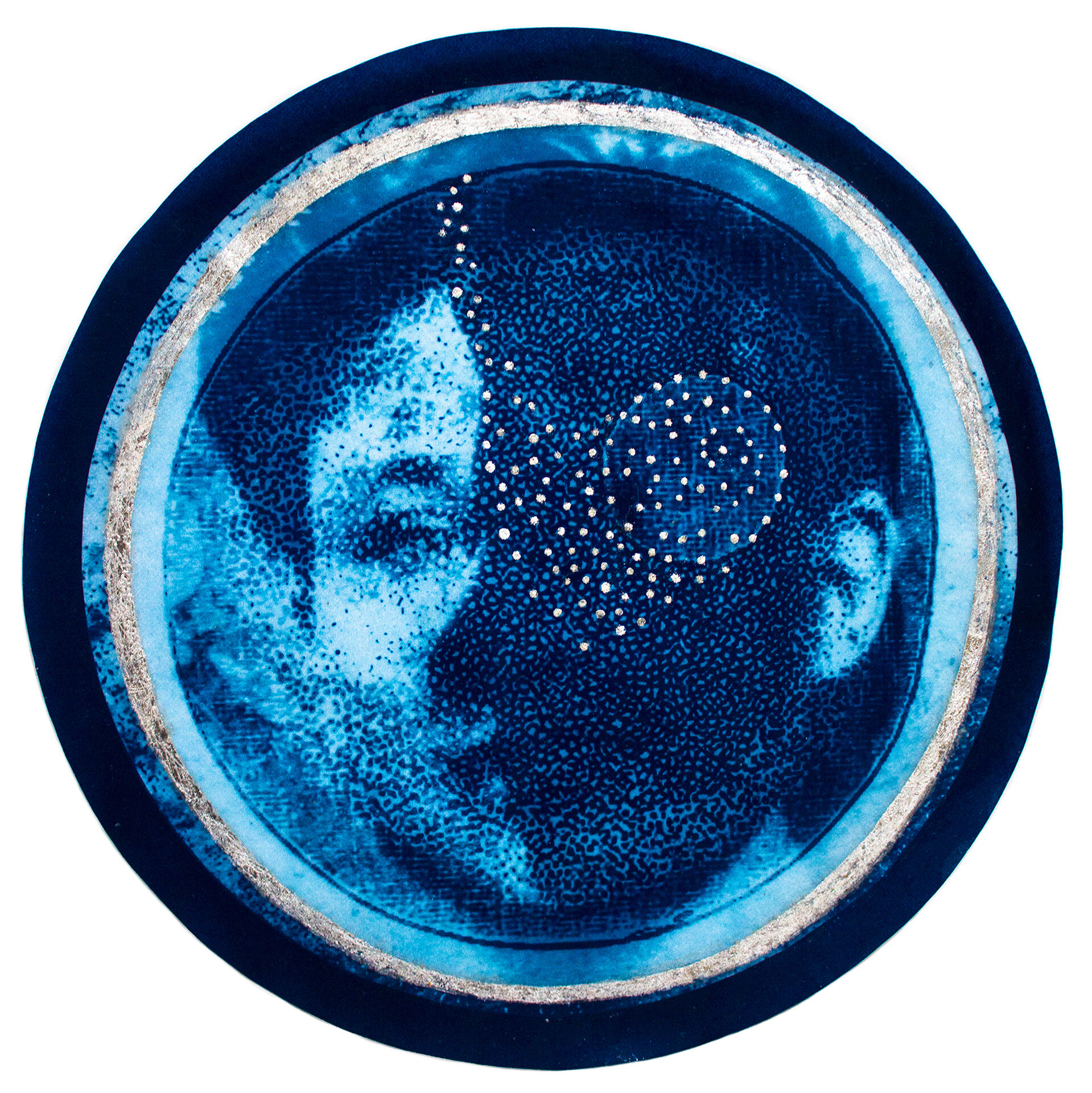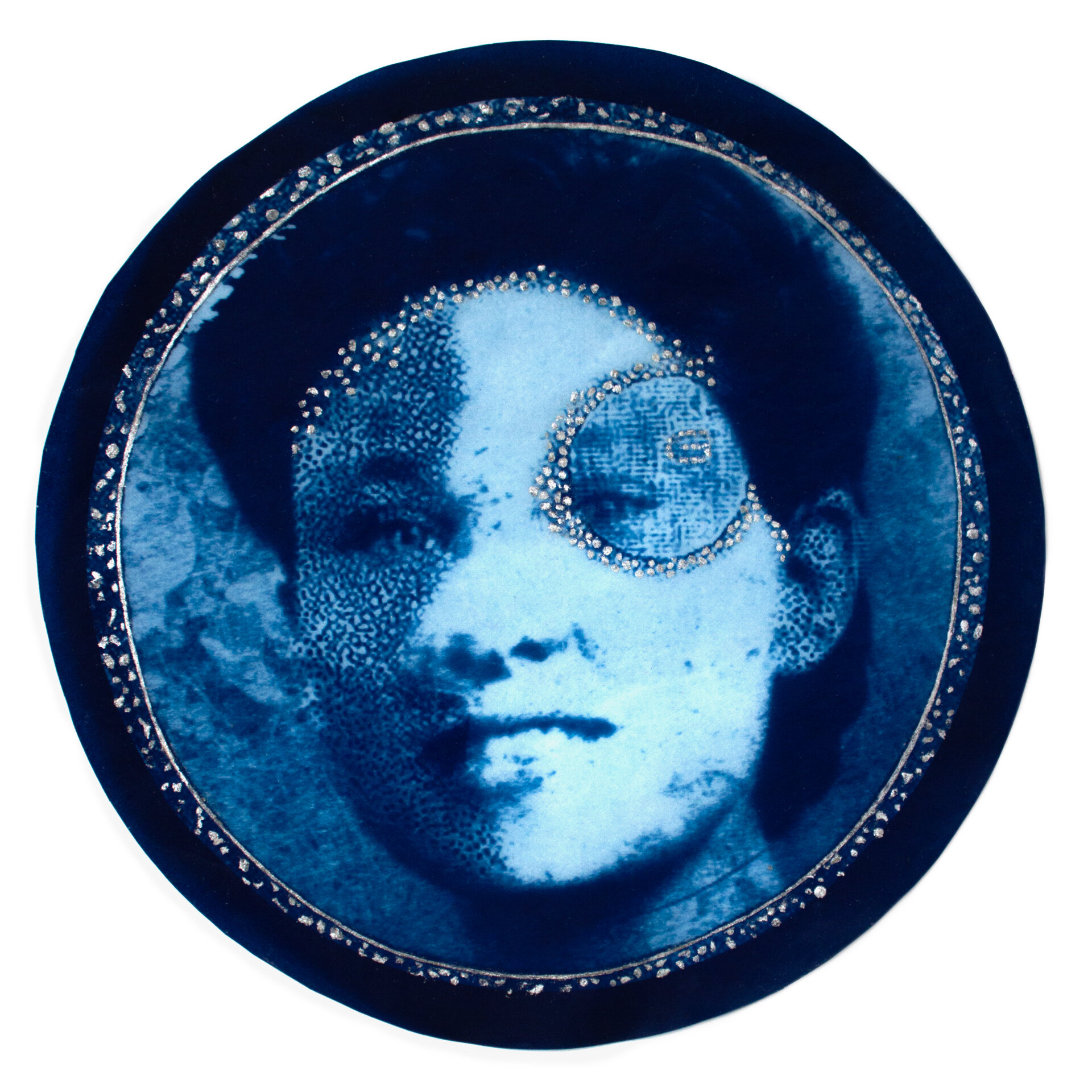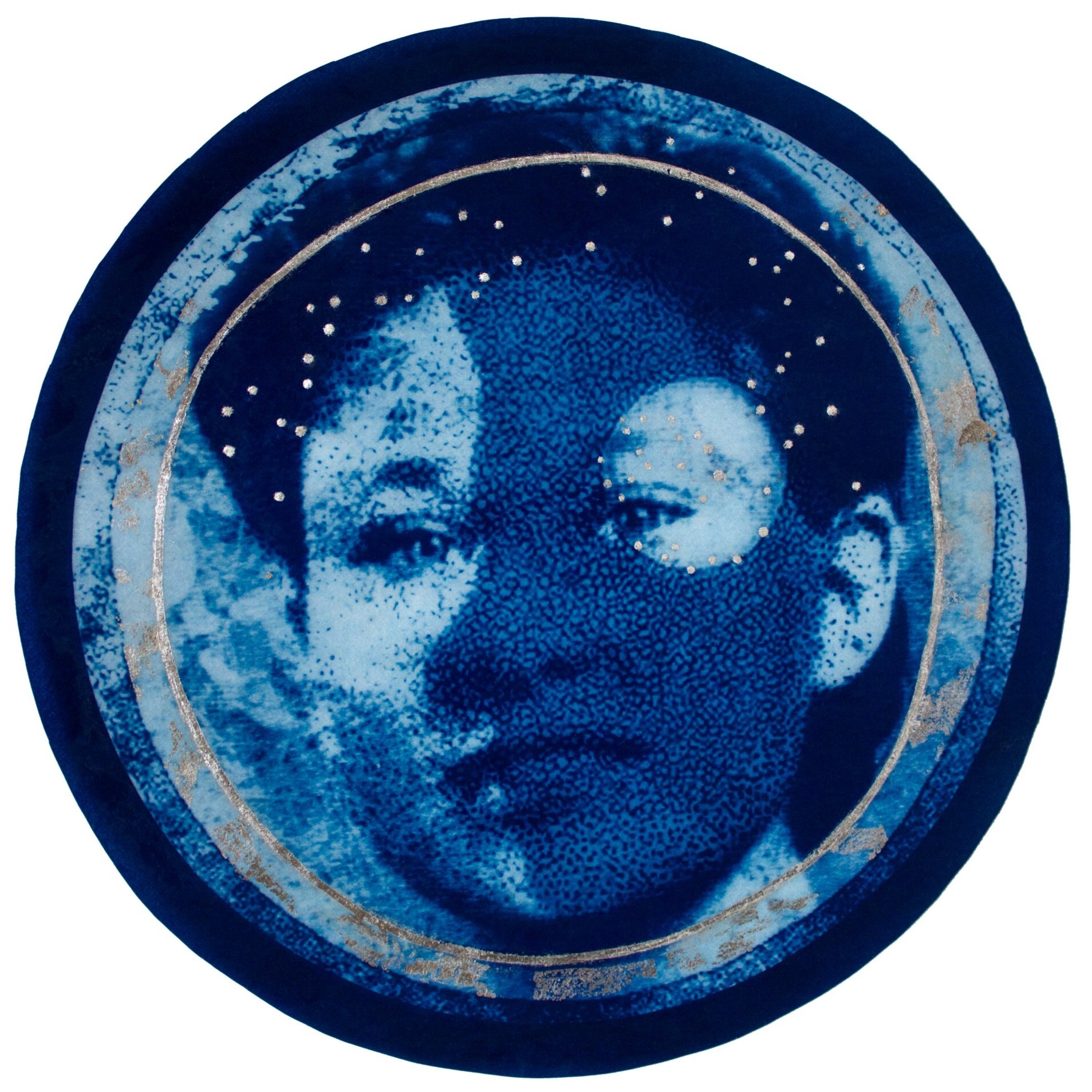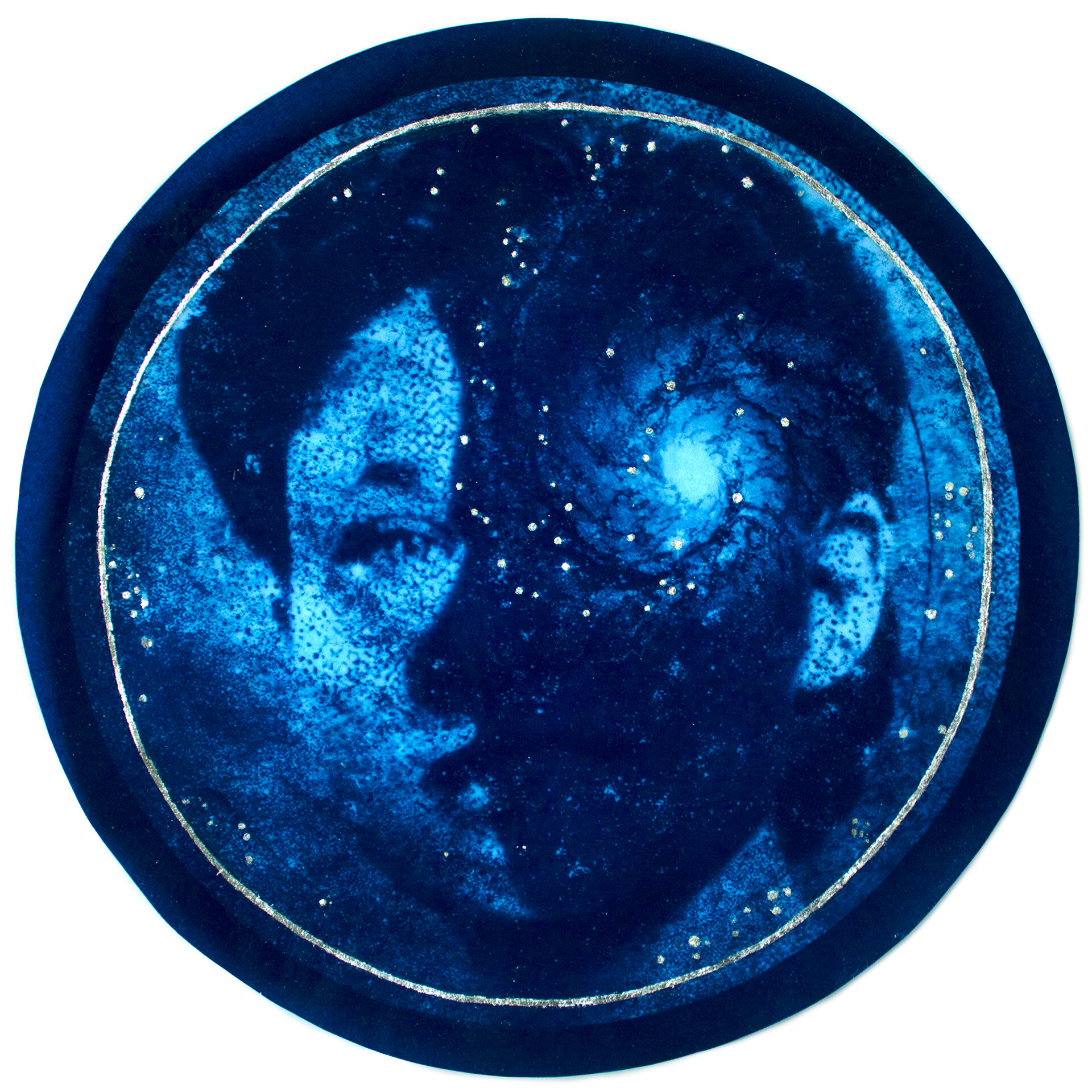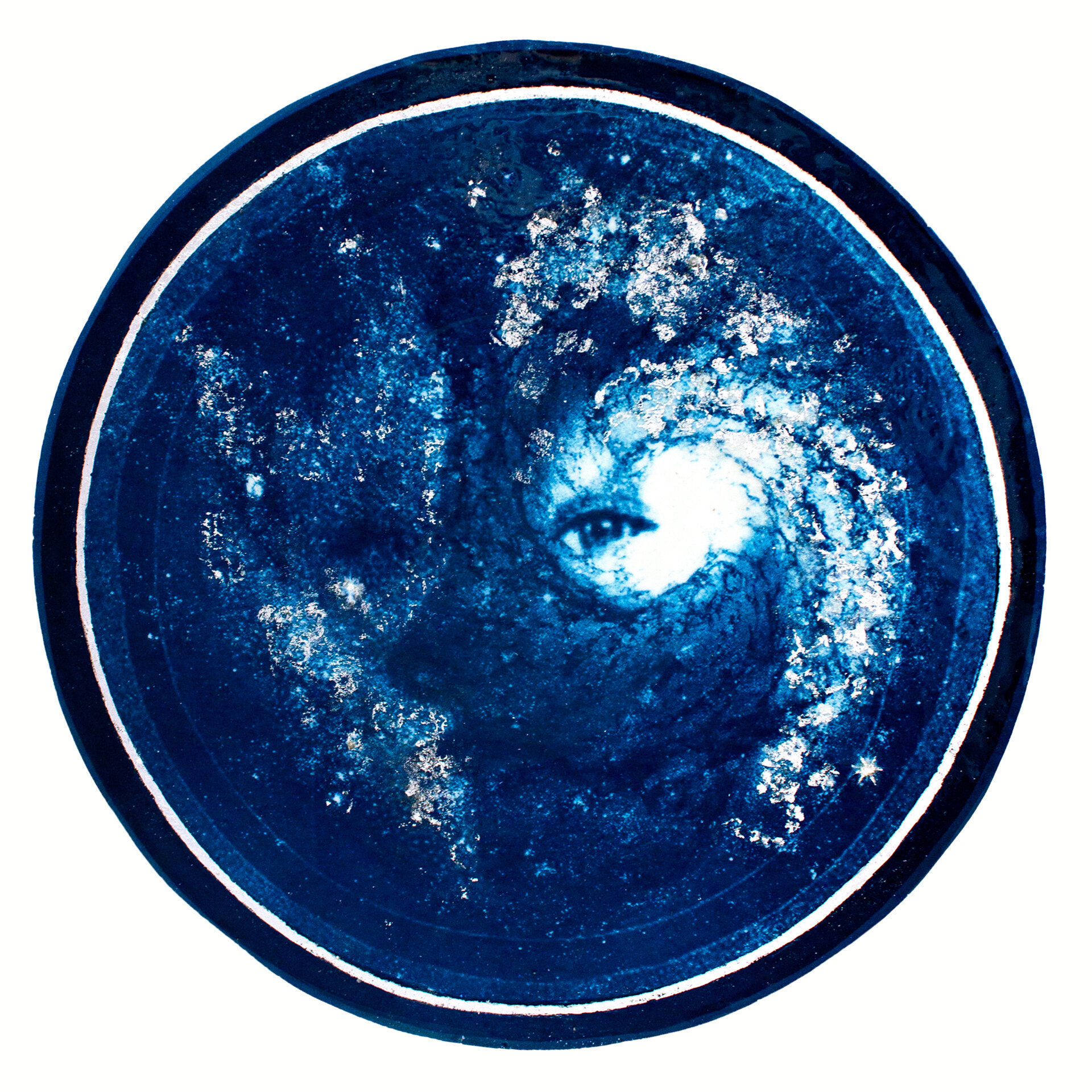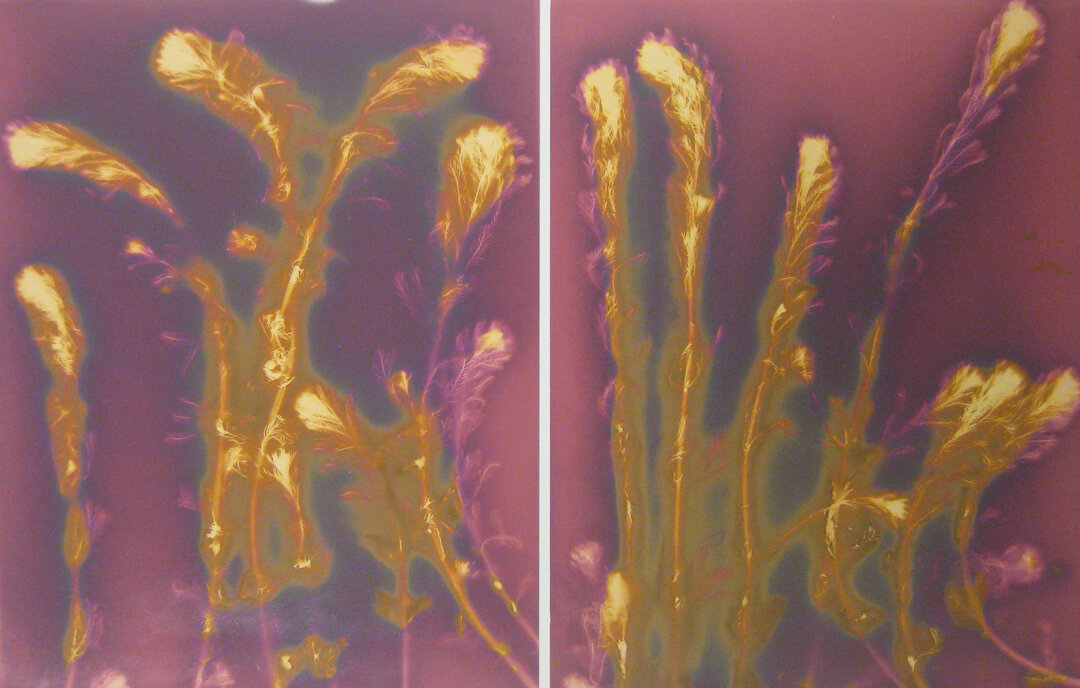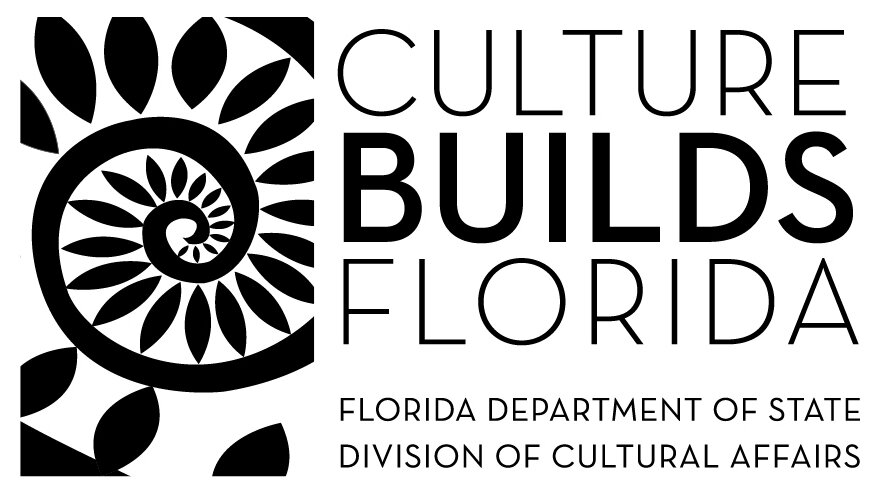Picturing the Avant-Garde:
A celebration of alternative and experimental processes
April 6th - June 26, 2021
Featuring photographs by:
Jaime Aelavanthara | Keliy Anderson-Staley | Patrick Scott Bell
Diana Bloomfield | Jillian Marie Browning | Kimberly Chiaris
Karen Hymer | Rachel Wolf
ARTISTS FROM THE PERMANENT COLLECTION:
Jerry Burchfield | R.H. LeSesne
Co-curated by Erin Gordon, Director, and Christina Katsolis, Education Coordinator
INTRODUCTION
Picturing the Avant-Garde aims to broaden the interpretation of photographic imagery beyond traditional printing. The works included in this exhibition explore the conceptual potentiality of various alternative and experimental photographic processes such as gum prints, tin types, chemigrams, cyanotypes, gold orotypes, and lumen prints among others.
Jillian Marie Browning, Relative #2, 2021, Cyanotype on cotton fabric, Courtesy of the artist.
Selections from the museum’s permanent collection from artists such as Jerry Burchfield and R.H. LeSesne complement the wide range of contemporary artists working in various media throughout North America. Each of the eight artists in this exhibition use interdisciplinary techniques to reframe the discussion around conventional image making.
This exhibition seeks to examine what makes an image a “photograph” and question the ambiguous borders that exist between photography, printmaking, bookmaking, and other media. Whether rendered on paper, metal, or fabric, the works on display showcase the unique characteristics – rich surface textures and tonalities, process variations, hand embellishments – embodied by these various historical photographic printing techniques. Each artist’s approach to their subject provides a sense of the immense variety of photographic possibilities at their fingertips.
These artists are not confined by the conventional principles of photography, but rather redefine those principles through their individual approach. For some, this means eschewing the use of camera and lens altogether. For others, this is accomplished by transforming images into three-dimensional sculptural objects. By engaging with the physical space through nontraditional installation methods, viewers are urged to consider photography beyond the flat two-dimensional framed image.
In addition to exploring the way photographic imagery is translated through process – the specific act of creation – the viewer is made acutely aware of the artist’s concept, and the conscious choices made in pairing visual and material means. The artists’ feelings and thoughts are of foremost concern; moving through the exhibition, the viewer is confronted by matters related to the circle of life, death, and decay; familial connections; identity and heritage; and the impermanence of memory.
Ultimately, Picturing the Avant-Garde seeks to expand the viewer’s appreciation and understanding of the possibilities of photography as an ever evolving artistic field.
Meet The Artists
JAIME AELAVANTHARA
Where the roots rise, in a forest full of ecru bone, the woman of the woods awakes to a world of myth and ruination. Where the roots rise and the sun seeds, decay runs rampant—seasons change. The woman passes through time like mist devolved—nature lies in wait to stake its claim.
Jaime Aelavanthara, A Wing Lifted, With No Twin, and Therefore, No Flight, 2021, Tea-stained cyanotype on paper, On Loan Courtesy of the Artist
This series articulates humankind’s capacity to decay as a marker of our identity. Set in the swamps and woods of Florida, Mississippi, and Louisiana - natural places where one encounters life and death, growth and decay, the series chronicles the intimate relationship of a woman and her surrounding nonhuman environment. The woman collects the bones, branches, and flora and treads with the animals, both dead and living. Recognizing the deaths of other creatures, this woman observes in death, she, too, will be repurposed and consumed by the earth. The cyanotype process shifts focus from potentially colorful landscapes and figures to patterns, textures, and the relationships of forms within the images. Tea-staining the prints dulls the blue and adds warmth. Printing on Japanese Kitakata paper - which is prone to ripping, tearing, and wrinkling - reflects the deterioration of nature and gives the prints a feeling of fragility. This work reflects upon the forms, the impermanence, and the interconnectedness of natural life.
Jaime Aelavanthara is a fine art photographer and educator based in Florida. Her photographic work explores themes of the human condition and our interconnectedness with nature. She has actively exhibited nationally and internationally in venues such as the Mississippi Museum of Art, SEITES Gallery, Canada, and the Ogden Museum of Southern Art. Her work is in public and private collections including the Mississippi Museum of Art in Jackson, the University of Arkansas in Little Rock, and the International House Hotel in New Orleans.
Jaime currently serves as an Assistant Professor of Art at the University of Tampa. She received her BFA from the University of Mississippi in Imaging Arts and her MFA in Photography from Louisiana Tech University. In the classroom, she teaches traditional black and white photography, digital photography, alternative photographic processes, and foundations 2D Design.
Keliy Anderson-Staley
Keliy Anderson-Staley, From the Baking Pan Series: An Incomplete Family History, 2000, Liquid Silver Emulsion on Metal, On Loan Courtesy of the Artist
Keliy Anderson-Staley was raised off the grid in Maine, studied photography in New York City and currently lives and teaches Photography and Digital Media at the University of Houston in Texas. She earned a BA from Hampshire College in Massachusetts and an MFA in photography from Hunter College in New York. Specializing in historical process including tin types, ambrotypes, and cyanotypes, Anderson-Staley’s work has been exhibited at the Akron Art Museum, The Bronx Museum of the Arts, the UCR/California Museum of Photography, the National Portrait Gallery, the Ogden Museum of Southern Art in New Orleans, among others. Her photographs are held in numerous public and private collections including the Cedar Rapids Museum of Art; the Library of Congress; The Museum of Fine Arts, Houston; and the Portland Museum of Art. A book of her tintype portraits, On a Wet Bough, was published by Waltz Books in 2014.
The Baking Pan Series: An Incomplete Family History
To produce these works, Keliy Anderson-Staley treated found baking pans with photographic chemicals and exposed images and text directly onto them. Baking pans have obvious domestic connotations, and here the artist explores her relationship with her divorced parents and siblings. Like illuminated panels from a larger narrative, each pan serves to tell a part of the artist’s family history. The images on the pans are newer photographs of Anderson-Staley’s family mixed with old found family snapshots. A number of untreated pans, and even one whose center has rusted out entirely, have also been incorporated into the grid to signify the biological father she had not yet met. Within the grid, these empty pans create negative space and a counterpoint to the portraits. The work as a whole suggests the construction of meaning and order out of memories and fragments, and the constitution a single family out of the diverse individuals who compose it.
Keliy Anderson-Staley, Origin stories on Yellow Notebook Pages, From the series: Raw Materials in Peace and War, 2020, Individual Cyanotypes (Palimpsest Grid), On Loan Courtesy of the Artist
PATRICK SCOTT BELL
Patrick Scott Bell, Untitled #10, Photograms, 2011, Chemigrams on photographic paper, On loan courtesy of the artist.
Patrick Scott Bell
This body of work is an exploration of incorporeality, or the state of no material existence.
The photograms in this series are time-lapse recordings of common household materials. (hard-surface cleaners, polyethylene wrap, carbonated beverages). The translucent materials interact on glass plates, interposed with light-sensitive paper. As the photographic paper is exposed to light, it records a visual documentation of a past experience. Much like an impression fossil, what is left behind is the absence of physical presence. The object can be interpreted, but never restored.
Patrick Scott Bell is a Daytona State College alumnus currently working as a Senior Video Producer at Treehouse in Portland, Oregon. He has a passion for creating fun, engaging video and photographic content for the web and uses his background in art, education, gaming, and technology to create content that is accessible to all. Tech industry leaders he’s worked with include Google, Adobe, Microsoft, IBM, and Amazon Alexa among others.
Diana Bloomfield
Diana Bloomfield lives and works in Raleigh, North Carolina, where she received her MA in English Literature and Creative Writing from North Carolina State University. An internationally exhibiting photographer for over thirty-five years, she has received numerous awards for her images, including a 1985 New Jersey State Visual Arts Fellowship, and five Regional Artist Grants from the United Arts Council of Raleigh, North Carolina. Most recently, she was awarded a 2019/20 Professional Development Grant from the United Arts Council of Raleigh. She was named a Critical Mass Finalist in 2014, 2018, and 2019.
Specializing in 19th century printing techniques, Diana's work has been featured in a number of books and included in a number of public and private collections. She teaches photography workshops throughout the country, and in her beautiful backyard studio.
Diana Bloomfield, Sunflower, From the series: The Old Garden, 2019, Tri-color gum bichromate over cyanotype, On Loan Courtesy of the Artist
Jillian Marie Browning
Jillian Marie Browning, Relative #14, 2021, Cyanotype on cotton fabric, On loan courtesy of the artist.
Artist Statement
rel·a·tive
: a thing having a relation to or connection with or necessary dependence on another thing
: a person connected with another by blood or affinity.
In this series, I reflect on the idea that when I was being formed in the uterus of my mother, my body was also creating my reproductive organs, which were forming my ovum. As my fetal cells were dividing and replicating, her chromosomes were copied into the fiber of my DNA. In turn, when my mother was developing inside her mother, her body was also forming her ovum - one that would eventually become me – forming a connection from grandmother, mother, and child many years before I would ever be conceived. This series explores the connection between motherhood, nature, and light.
Jillian Marie Browning (she/they) is a Daytona State College alum and an interdisciplinary artist pursuing themes of feminism, identity, and the contemporary black experience. They received a BS from the University of Central Florida in Photography and an MFA in Studio Art from Florida State University. They are a nationally exhibited artist whose work is included in the permanent collections of the Center for Photography at Woodstock, the University of Minnesota, Morris, and the University of Maryland’s David C. Driskell Center for the Study of Visual Arts and Culture of African Americans and the African Diaspora. They currently work for The School of Art + Art History at the University of Florida in Gainesville, Florida.
Jillian Marie Browning, Golden (Girl) 1, 2021, Steel backed photopolymer plate, On Loan Courtesy of the Artist
golden (girl)
This series explores how body image is often closely intertwined with one’s self worth and the inherent value placed on a particular range of body shapes and sizes deemed “acceptable” in contemporary society.
Using an historical process similar to etching or photogravures, the artist produced this series by creating high-contrast vignettes of parts of their body and then exposing the transparency print on top of a metal plate coated with a light sensitive emulsion. As the emulsion hardens in the sun, a subtle impression on the golden plate is left behind.
Jillian Marie Browning, Matriarchal Line/Close Knit Family, Cyanotype on cotton fabric, On loan courtesy of the artist.
Matriarchial line / close-knit family
Paying homage to the botanical studies of renowned English botanist and cyanotypist Anna Atkins (1799-1871), this installation of cyanotypes features the hair of the artist, their sisters, and their mother. This work acts as a portrait of the women in their family while interrogating the value placed on the texture and length of black women’s hair in contemporary society. The physical depiction of the hair prints in a round state resemble DNA strands viewed through a microscope, referencing their genetic matriarchal bond and echoing Atkins’ blending of art and scientific study. Coupled with locally collected southern flora on domestic materials such as cotton fabric, crocheted doilies, and embroidery hoops this work alludes to traditional “acceptable” forms of women’s artistry and the feminine connection with nature.
Kimberly Chiaris
Kimberly Chiaris, Enigma, From the series: Tableaux, 2020, Cyanotype with wine tannin and coffee toning on Kozo paper; Protected with Renaissance wax, On Loan Courtesy of the Artist
Kimberly Chiaris received her BFA in Photography from the Kansas City Art Institute. She currently lives in Colorado. Her interest lies mainly in personal story telling through handmade processes. She blends historical imagery with contemporary imagery in hopes of creating a visual conversation that transcends time as well as speaks into the future. Her practices often involve digital composites combined with analog and alternative processes that include elements of mixed media. Her focus is primarily on themes of origin and identity and how trace memory, emotions, time and culture shape and shift our understanding of history.
She has recently exhibited in FotoFest, SE Center for Photography, PhotoPlace Gallery, L.A. Photo Curator, Art Intersection, The Hand Magazine, Candela Books and Gallery.
Kimberly also loves teaching and igniting curiosity in people through art processes. She has taught numerous photo based art classes and workshops at Universities, Colleges, Museums, galleries, Artist associations and nonprofit organizations.
ARTIST STATEMENT
Stories put us in touch with our origins, binding us to a collective culture and set a context for understanding ourself and our history. Stories bring identity and add significance to our personal and collective existence. I am interested in the shifting fluidity of how our Story is told over time and how memory plays a malleable and emotional role in the telling and shaping of these recollections.
I am on a quest to mine new anecdotes that arise from family conversations, photographs and inherited treasures. Out of these accumulated artifacts and stories, I extract new narratives to present as fresh visual tableaux. I blend digital contemporary imagery and ideas with historical relics to create a new folklore that transcends a chronological timeline. This series of work contains a mix of imagination, facts and recollections that invite a dialogue concerning trace memory, identity, origin, ancestry and history.
Kimberly Chiaris, Left to right: Beyond a Shadow 1, Beyond a Shadow 2, Beyond a Shadow 3, Beyond a Shadow 4, Beyond a Shadow 5, Beyond a Shadow 6 From the series: Beyond a Shadow, 2018, On Loan Courtesy of the Artist
Beyond a Shadow
When my mother passed away somewhat suddenly, it brought to the surface of my conscious mind, memories and questions about my ancestors. I thought about genetic and physical similarities as well as personality traits that I received from my mother and processed through my relationship with her. I thought about the many mysteries that would never to be solved because of stories untold or forgotten.
I began studying the photographs that I inherited from her and was drawn to the images of her as a young woman before she finished college, married, started a career, had children, and full of hopeful aspirations. She was younger than me, even younger than my children in these photos. This was a face of expectancy on the verge of adulthood with so many dreams yet to be realized.
I created this series by digitally merging my mother’s image with a shadow image of myself. I layered these images with a 19th century illustration of a human ovum and an image of a galaxy taken with the Hubble space telescope. After making a cyanotype, I added silver leafing to each finished piece to emphasize the preciousness of life. Each of the 6 pieces sequentially morph from portrait to galaxy, the physical body joining with a larger eternal story. The micro and macro mirror each other while the finite dissolves into infinity.
Kimberly Chiaris
Karen Hymer
Karen Hymer, Lumen #76, Sea Plants, From the series: Botanicals, 2016, Archival Pigment Print, On Loan Courtesy of the Artist
Karen Hymer, Lumen #57, Unknown Plant, From the series: Botanicals
2014, Archival Pigment Print, On Loan Courtesy of the Artist
Karen Hymer, Lumen #31, Texas Ranger Flowers, From the series: Botanicals, 2016, Archival Pigment Print, On Loan Courtesy of the Artist
Karen Hymer was born in Tucson, Arizona and has spent most of her life in the Sonoran desert. Karen’s experience and technical interests are wide-ranging. Although “trained” as a photographer and educator, her approach to image making explores the blending of photosensitive materials, digital media, and printmaking. She is fascinated with how the passage of time affects the human body and other natural elements in the world. She works with various photography processes including photopolymer gravure, cyanotype, palladium, gum dichromate and photo-encaustics.
Hymer actively exhibits her work both nationally and internationally. Her work is featured in Clay Harmon’s book Polymer Photogravure: A Step-by-Step Manual, Highlighting Artists and Their Creative Practice, is included in Jill Enfield’s Guide to Photographic Alternative Processes and is in several public collections, including the Center for Creative Photography and the Polaroid International Collection.
In addition to working as a fine art photographer, Karen has taught photography for over 25 years at Pima Community College, Tucson, AZ. She relocated to Silver City, NM in the summer of 2018 to open and operate Light Art Space. The space features galleries, a sculpture garden/event space, wet darkrooms, a printmaking studio and teaching space. Karen teaches workshops in photopolymer gravure, cyanotype, and other photographic processes. Workshops in wet plate, watercolor, printmaking and other art processes are offered.
Botanicals
This series spans many years and reflects my interest in the flora of places I call home. Within the “Botanical” series there are sub-series including “Invasive Species” and “Chaos”. While exploring my environment, I observe, photograph, and collect specimens. In some cases the final work includes camera images while others are made with direct contact with the plant matter. Playing with light sensitive processes and working with a variety of papers and fabrics, hand applying emulsions, and using the sun for exposures lends itself to unpredictable results. Letting go of control and observing the alchemy before me is a welcomed relief from modern life. The processes in this series include Cyanotypes, Lumens, Photopolymer Gravure and etchings. My intention is not to replicate nature but rather to create unique, impressions of beauty.
The works on display in “Picturing the Avant-Garde” are archival pigment prints from original lumen prints. The lumen prints were made on a variety of photographic back and white paper, some of it well passed the expiration date. The plants were laid directly on the photo paper, presses under glass and exposed for hours in the sun. Moisture from the plants, condensation, and hand applied liquids react with the paper producing fluid, colorful results. Each paper reacts differently depending on moisture, heat, UV intensity, and exposure time. It is my hope the viewer will find pleasure in a new way of experiencing impressions of the wondrous plants that surround us.
Karen Hymer (2021)
Return to Enchanted Lands
In 2018 I returned to live in New Mexico, the Land of Enchantment. It really is a place like no other and is indeed enchanted. The light is magical, the land speaks a different language, and it is now my home. This past year I began photographing the land as I traveled the state. I was excited to return to New Mexico, though I have to say the neighboring Sonoran desert, the place of my birth, will always draw me back. As a westerner, I gain great pleasure from driving the back roads, exploring the natural and human–touched environment. These images were taken with my iPhone; that ever present tool. They are archival pigment prints on vellum, backed with 24k gold leaf. The images are printed small, requiring the viewer to come close in order to see the detail. This may seem to contradict an initial impression of the land: large, expansive, endless. I instead feel an intimacy and personal connection with this land and hope the viewer might also experience this through my images.
Karen Hymer (2021)
Rachel Wolf
Rachel Wolf is a professional photographer who specializes in camera-less photography, alternative / antique processes, and creates immersive environments through light-based installations. Many of her projects are experiments in which the external world becomes a way of considering inner reality and visual perception.
One of her principal methods of working involves directly exposing photographic paper to light and chemicals, making these primary photographic elements, that are often invisible, become tangible. These essential matters become the tools, subjects and direct chemical process that create the image. This is camera-less photography as alchemical practice.
Rachel Wolf, Alchemy 59, 2017, Chromogenic Chemigram, On Loan Courtesy of the Artist
Rachel is an educator and speaker in the field of photography. She exhibits her work nationally, and is collected in private and public collections. Originally from Anchorage, Alaska, Rachel earned her BA from Hampshire College and her MFA from Pacific Northwest College of Art. Rachel lives in Portland, OR.
ALCHEMY
My photographic work is camera-less, meaning that I am creating my images solely in the darkroom without negatives to print from. Light, shadow, and chemicals are my primary tools and subjects. Working with these and other elements, I create my images by directly exposing the photographic paper. In this way, I am not reproducing an image of something, but producing an image from my own imagination and the indexical traces of the materials used. These images are not abstractions of something, but concretize something new. They are devoid of references connecting them to the visual reality we are used to seeing.
Rachel Wolf, Life on Mars, 2017, Chromogenic Luminogram, On Loan Courtesy of the Artist
SPECTAGRAMS
The lack of color processors in Portland had kept me from making color images for a long time. My desire to work with color took over and so now in almost complete darkness, I am armed in rain gear and a respirator making color photograms by hand. The colors in these images come from breaking white light into the spectrum of color using prismatic materials. I am fascinated by rainbows and their ability to illustrate what human color vision is capable of, its limits and potential.
ARTISTS FROM THE PERMANENT COLLECTION
Jerry Burchfield
Jerry Burchfield, Myrophyllium Aquaticum (Mermaid Weed) from "Understory" Series, 2008, Lumen Print, Gift of Barbara Burchfield. 2010.16.1
Jerry Burchfield (American, 1947 – 2009) began experimenting with color photography in the early 1970s by making photograms with standard chromogenic paper and exploring the possible applications of color and light in camera-less images – a process also known as lumen prints. Throughout the 1970s, he continued to explore alternative uses of color photography using different techniques, incorporating multiple exposures, using various procedures to make photographs without a camera, and making physical alterations to the prints. Burchfield has pursued a number of long-term projects that use different forms of photography to examine processes of change and subjects like humankind's precarious relationship with nature.
Burchfield created these images by placing plant specimens onto photographic paper and allowing the interaction of sunlight, weather, temperature, and the plant's natural moisture to produce supernatural images. Each resulting image is unique and mysterious with dynamic ranges in tones and colors.
"Even more than conventional photography, which after a time offered less of a challenge, making the lumen prints sharpened my sense of line, color and design." – Jerry Burchfield
R.H. LeSesne
Richard Habersham LeSesne (American, 1880 – 1946) was born in Clarkesville, Habersham County, Georgia and settled in Daytona Beach, Florida by 1908. His reputation as a photographer is primarily tied to the Daytona Beach Speedway where he documented the land speed record attempts from the 1920s through the 1930s. However, as Daytona Beach gained as a winter destination for those further north wanting warmer climes, he seemed to have established a market for his local landscapes, using the orotype process made famous by Edward S. Curtis.
The luminous golden sheen is what gives this process its name – orotoype, also called orotone – which comes from the Latin prefix oro- meaning “gold.” Orotypes were traditionally created by printing a positive on a glass plate pre-coated with a silver gelatin emulsion. Following exposure and development, the back of the plate was then coated with banana oil impregnated with gold-leaf or gold-colored pigment, to yield a gold-toned image. These images by LeSesne feature historic Florida waterscapes dating back to 1910. The deep, dimensional effect that is formed comes from the reflectivity of the gold leaf and the internal reflections that are created due to the spatial separation between the gold and image layers.
R.H. LeSesne, Untitled (Landscape), c. 1910, Orotype, Gift of anonymous donor. 2019.1.1
Behind The Scenes Videos
Gallery Walkthrough
Events
360° Tour
Sponsored in part by the State of Florida, Department of State,
Division of Cultural Affairs and the Florida Council on Arts and Culture.












